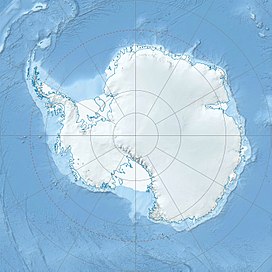Mount Giles (75°9′S 137°37′W / 75.150°S 137.617°W) is a mainly snow-covered mountain, 820 metres (2,690 ft) high, located 5 nautical miles (9.3 km; 5.8 mi) south-southeast of Lynch Point on the coast of Marie Byrd Land, Antarctica. The mountain is the highest elevation on the divide between the seaward ends of Frostman Glacier and Hull Glacier.[1]
| Mount Giles | |
|---|---|
| Highest point | |
| Coordinates | 75°9′S 137°37′W / 75.150°S 137.617°W |
Discovery and name
editMount Giles was discovered on aerial flights from the West Base of the United States Antarctic Service (USAS) in 1940. It was named for Walter R. Giles technical sergeant, United States Marine Corps (USMC), copilot and radio operator on some of these flights.
Location
editMount Giles is the high point of the divide between Frostman Glacier to the west and Hull Glacier to the east before they enter Hull Bay on the coast of Marie Byrd Land. Other features of the divide include the Konter Cliffs, Lynch Point and Miller Spur.[2]
Layered gabbro crops out at Mount Giles, holding quartz-free plagioclase, clinopyroxene and olivine. Isotope analysis indicates an age of 154±35 million years.[3]
Features
editKonter Cliffs
edit75°06′S 137°48′W / 75.100°S 137.800°W. A line of cliffs, 360 metres (1,180 ft) high, which surmount the east side of the terminus of Frostman Glacier. Mapped by USGS from surveys and United States Navy tricamera aerial photographs, 1959-65. Named by US-ACAN for Richard W. Konter, a member of the ship's party on the City of New York during the ByrdAE, 1928-30.[4]
Miller Spur
edit75°07′S 137°29′W / 75.117°S 137.483°W. An ice-covered spur that descends northeast from Mount Giles. The spur terminates in a small rock bluff about 1 nautical mile (1.9 km; 1.2 mi) west of lower Hull Glacier. The feature was observed and photographed on December 18, 1940, from aircraft of the USAS (1939-41) led by Admiral Richard Byrd. Named by US-ACAN for Linwood T. Miller, sailmaker and member of the Byrd Antarctic Expedition, 1933-35, who produced windproof shirts, parkas, tents and other canvas materials for the expedition.[5]
References
edit- ^ Alberts 1995, p. 278.
- ^ Hull Glacier USGS.
- ^ Metcalfe, Sporli & Craddock 1978, p. 6.
- ^ Alberts 1995, p. 401.
- ^ Alberts 1995, p. 492.
Sources
edit- Alberts, Fred G., ed. (1995), Geographic Names of the Antarctic (PDF) (2 ed.), United States Board on Geographic Names, retrieved 2023-12-03 This article incorporates public domain material from websites or documents of the United States Board on Geographic Names.
- Hull Glacier, USGS: United States Geological Survey, retrieved 2024-03-24
- Metcalfe, Anne P.; Sporli, K.B.; Craddock, Campbell (October 1978), "Plutonic rocks from the Ruppert Coast, West Antarctica" (PDF), Antarctic Journal, retrieved 2024-03-24
- This article incorporates public domain material from websites or documents of the United States Geological Survey.
